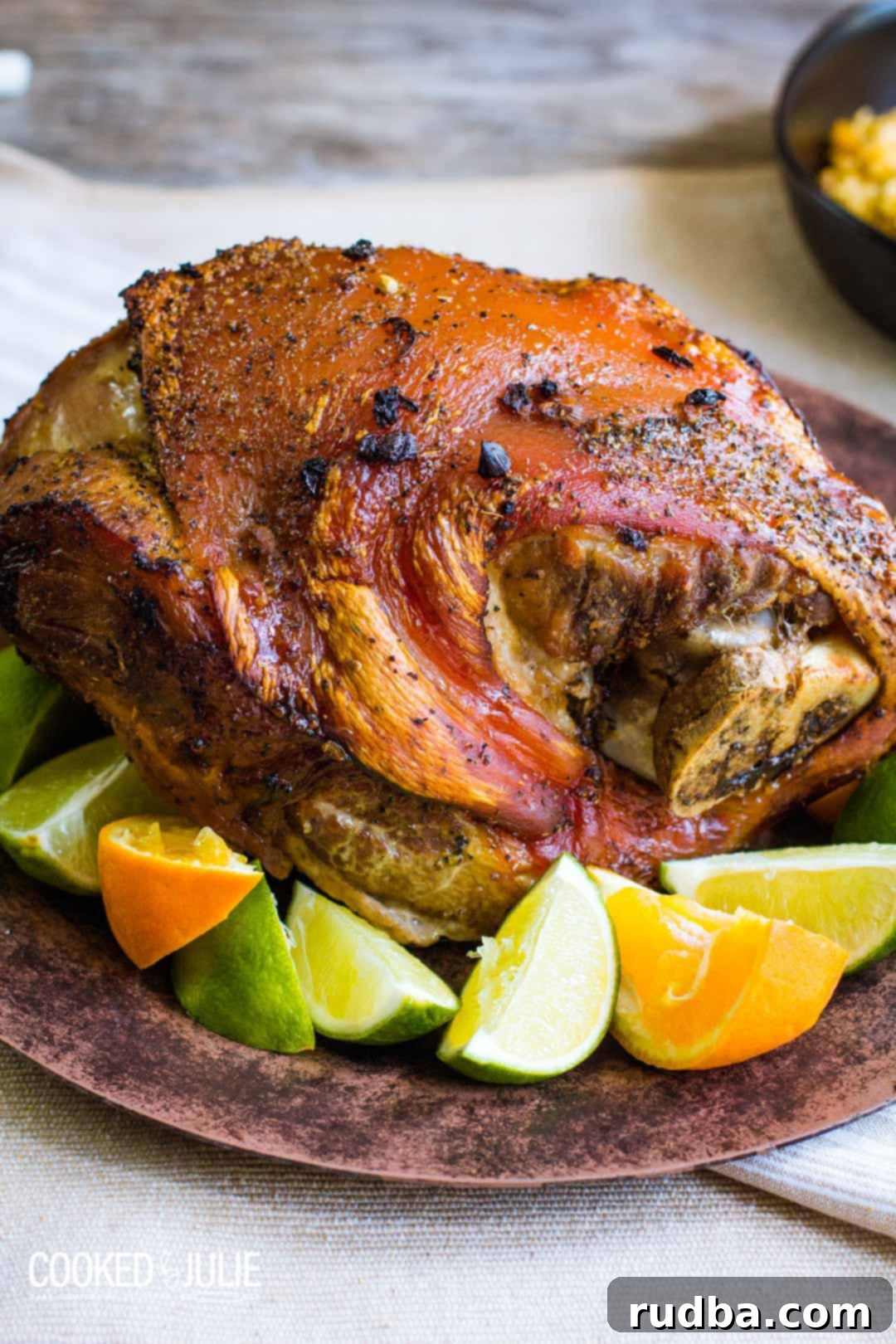Authentic Pernil Recipe: The Ultimate Crispy & Juicy Roasted Pork Shoulder for Any Celebration
Pernil isn’t just a meal; it’s a celebration! For many families, including mine, this succulent, well-seasoned roasted pork shoulder with its famously crispy skin is the star of every Christmas Eve feast. Prepare to be amazed by a dish that’s as flavorful as it is impressive.
This traditional Pernil is a beloved Holiday favorite, perfectly complemented by classic sides like Congri (Cuban Black Beans and Rice) and a refreshing glass of Coquito. Its rich history and incredible taste make it a staple in Caribbean households, especially in Cuba, the Dominican Republic, and Puerto Rico, where it brings families together around the table.
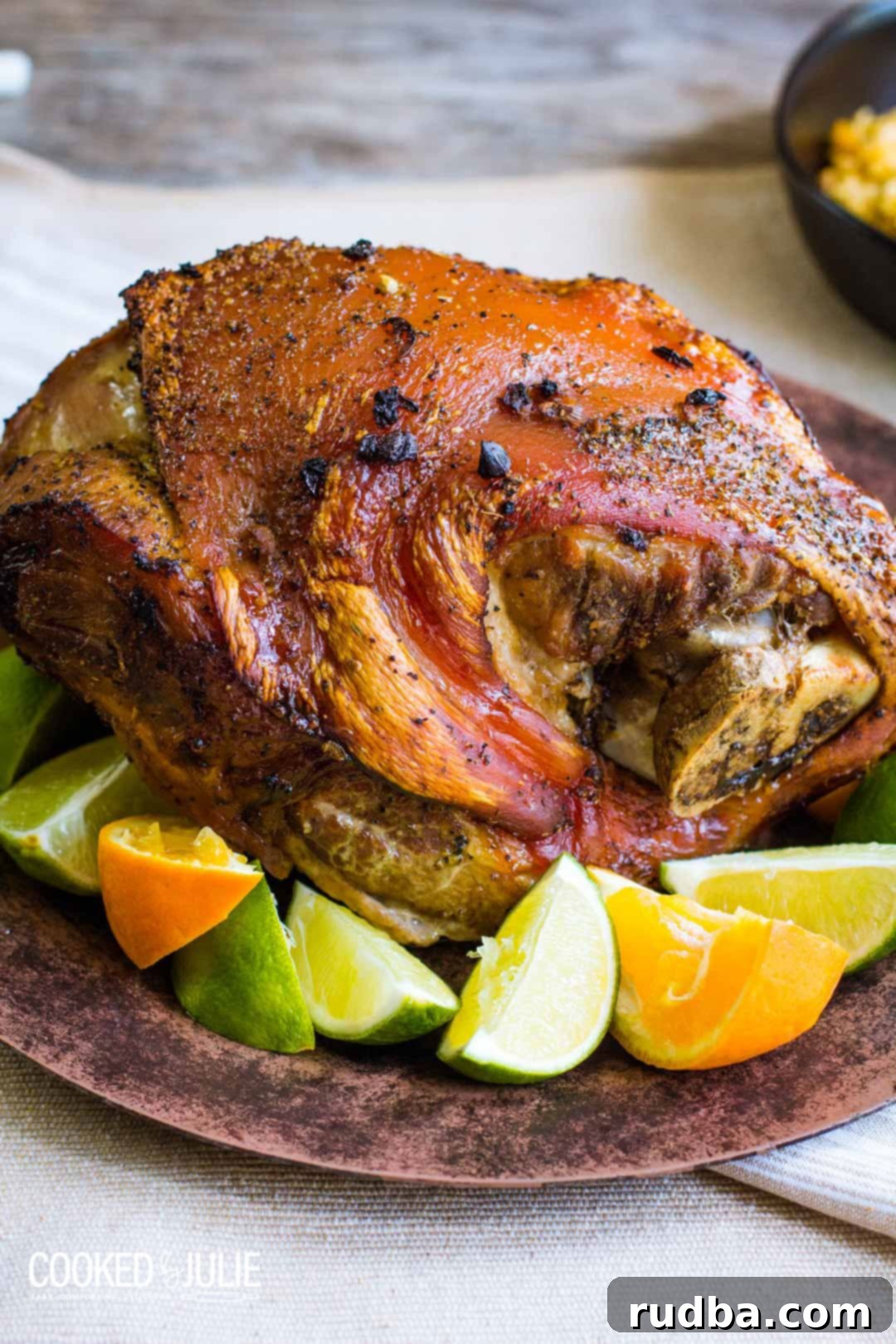
What is Pernil? A Culinary Tradition and Holiday Centerpiece
Pernil refers to a bone-in, slow-roasted, marinated pork leg or pork shoulder. It’s an iconic dish, deeply rooted in the culinary traditions of several Latin American countries. More than just roasted pork, Pernil embodies the spirit of communal gatherings and festive occasions. Its preparation is a labor of love, yielding incredibly tender meat infused with aromatic spices and a signature crispy, crackling skin (often called “cuero” or “cuerito”). The meticulous slow-roasting process ensures that every fiber of the pork is permeated with flavor, resulting in a melt-in-your-mouth experience.
This magnificent roast is ideal for large gatherings, thanks to its substantial size, easily feeding a crowd with minimal effort once it’s in the oven. Beyond its capacity to serve many, it’s arguably one of the most delicious and satisfying meals you can offer your guests, making any occasion feel special. And the absolute best part? The leftovers! Transform any remaining Pernil into incredible Cuban sandwiches, savory tacos, or other creative dishes for days of continued enjoyment, making this recipe truly versatile and rewarding.
Why This Pernil Recipe Stands Out From the Rest
There are countless Pernil recipes out there, but this particular method is tried and true, guaranteeing a result that will impress even the most discerning palates. Here’s why this recipe is a must-try for your next family gathering or holiday feast:
- Unmatched Tenderness and Juiciness: The slow roasting method, combined with our special marinade, ensures the meat is incredibly tender, moist, and succulent. It practically falls off the bone with minimal effort, making it a joy to eat.
- Profound Flavor Infusion: Our delicious homemade sour orange marinade, affectionately known as ‘mojo,’ isn’t just a surface coating. It penetrates deep into the meat through strategically placed slits, creating a rich, tangy, and garlicky flavor profile that is utterly irresistible and authentically Caribbean.
- Surprisingly Effortless Preparation: While Pernil might seem intimidating, this recipe simplifies the process. There’s no need for continuous basting while it bakes, and while marinating overnight is an option for deeper flavor, it’s not strictly necessary. This allows you to enjoy your holidays without constant kitchen duty.
- The Coveted Crispy, Golden Skin: We use a unique two-stage roasting process that guarantees that glorious, shatteringly crisp pork skin (cuerito) that everyone fights over. It’s the perfect textural contrast to the tender meat.
- Economical and Hearty: Pork shoulder is an inexpensive cut of meat, making this a budget-friendly option for feeding a large family or party without compromising on taste or quantity. It’s a hearty meal that truly satisfies.
- Diet-Friendly Options: With over 40 grams of protein per serving, it’s a satisfying and hearty meal. Plus, it’s naturally low-carb and keto-friendly, fitting various dietary needs without alteration.
- Versatile Serving: Whether you prefer to slice the meat into thick, juicy portions or shred it for a pulled pork style, the choice is yours. Crucially, the meat can be returned to the baking dish to soak up all those delicious, released juices, enhancing its flavor and moisture even further.
Essential Ingredients: The Heart of Your Authentic Pernil
Crafting the perfect Pernil starts with high-quality ingredients, particularly for the incredible mojo marinade that gives it its distinctive flavor. While the full list with exact quantities is available in the recipe card below, let’s highlight some key components and their crucial role in achieving that authentic Caribbean taste:
- Bone-in Pork Shoulder (Pernil): This is undeniably the star of our dish. We highly recommend opting for a bone-in cut, often referred to as ‘shoulder picnic’ or ‘pork butt’ (despite the name, this cut comes from the shoulder). The bone is essential, as it adds immense flavor to the meat and helps keep it moist and tender during the long, slow roasting process. A larger cut (e.g., 8 lbs or more) is ideal for feeding a crowd and ensuring enough delicious leftovers.
- Fresh Oranges and Limes, Juiced: The fresh juice from these citrus fruits forms the vibrant, acidic base of our “mojo” marinade. This acidity is crucial for tenderizing the pork fibers and imparting a bright, zesty flavor that is characteristic of authentic Caribbean cuisine. Using freshly squeezed juice is paramount – do not substitute with bottled juice for the best, most authentic results.
- Fresh Garlic, Minced: Garlic is more than an ingredient in Pernil; it’s a foundational flavor. You’ll need a generous amount of freshly minced garlic to create a pungent, aromatic, and deeply savory foundation for the marinade. It’s truly what gives Pernil its signature robust taste, working in harmony with the citrus.
- Sazon Goya: This is a secret weapon for many Latin American dishes! Sazon Goya is an all-purpose seasoning blend that adds not only a beautiful, rich color to the pork but also a complex blend of spices (often including coriander, annatto, and cumin) that are essential for an authentic flavor profile. You can typically find it in the Hispanic section of your local grocery store.
- Oregano & Cumin: These classic dried spices complement the fresh garlic and citrus perfectly. Oregano provides an earthy, slightly peppery note, while cumin adds a warm, savory depth that is indispensable in Caribbean cooking. They help to round out the marinade’s complex flavor.
- Kosher Salt and Black Pepper: Beyond basic seasoning, kosher salt plays a critical role, especially for achieving that perfectly crisp pork skin. You’ll need a good amount for the marinade itself and then an additional, generous amount for seasoning the pork skin to draw out moisture and promote maximum crispness. Freshly ground black pepper adds a subtle heat and aromatic complexity.
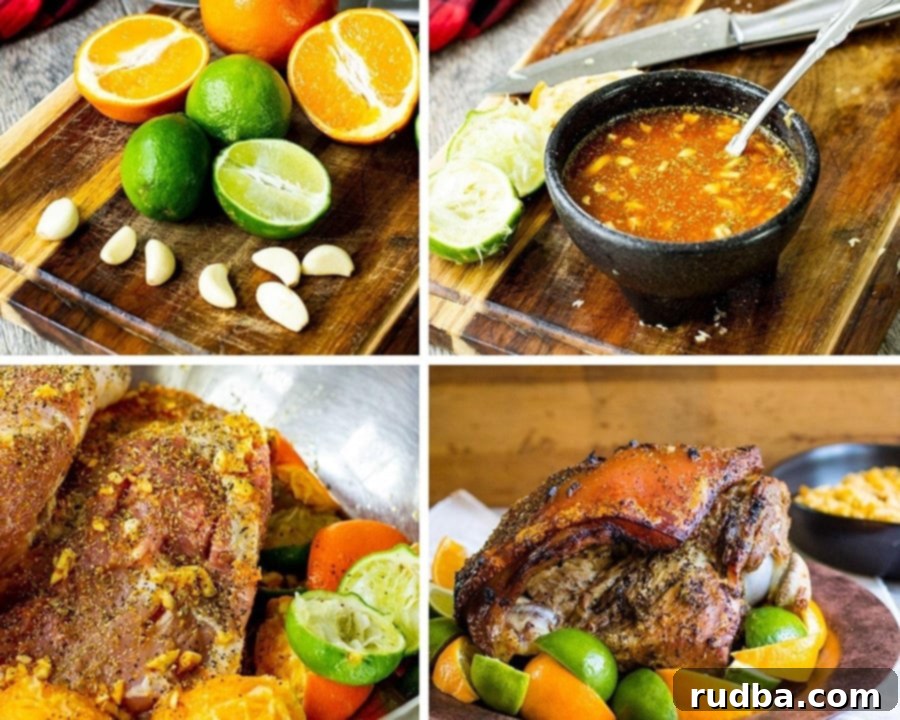
Mastering the Art of Pernil: Top Tips for a Flawless Roast
Achieving a truly spectacular Pernil involves a few key techniques that elevate it from a good roast to an unforgettable one. Follow these expert tips closely to ensure your pork shoulder is incredibly tender, bursting with flavor, and crowned with that irresistible crackling skin:
- Proper Pork Preparation for Maximum Marinade Penetration: This step is critical for a flavorful Pernil. Carefully pull back the pork skin from the shoulder (ensure it remains attached at one end, forming a flap). Using a sharp knife, pierce several deep, 1-inch cuts or slits all over the exposed flesh of the pork. These pockets are vital for allowing the potent garlic-citrus mojo marinade to truly permeate the meat. Don’t be shy; make sure those minced garlic chunks and other marinade ingredients find their way deep into these slits for an even flavor distribution throughout the entire roast.
- Bring Pork to Room Temperature Before Roasting: For even cooking and to ensure the meat stays as tender as possible, it’s crucial to allow your pork shoulder to sit at room temperature for at least 30 minutes (or up to an hour for larger cuts, like an 8lb pernil) before placing it in the oven. Roasting cold pork directly from the refrigerator can lead to uneven cooking, where the outside cooks too quickly while the inside remains undercooked, and results in a longer overall baking time.
- The Secret to Super Crispy Skin: Keep It Dry and Seasoned: This is the absolute key to achieving that coveted, shatteringly crisp “cuerito.” After generously applying the marinade to the meat, return the pork skin to its original position over the shoulder. Then, meticulously pat the entire surface of the skin as dry as possible with paper towels. Any moisture on the skin will steam it rather than crisp it. Once thoroughly dry, generously season the skin with extra Kosher salt and a good sprinkle of black pepper. This initial seasoning and dryness are crucial for rendering the fat and developing that desirable crunch during the high-heat stage.
- Employ the Covered and Uncovered Roasting Method: To achieve the perfect balance of tender, juicy meat and crispy skin, a two-stage cooking process is essential. Begin by cooking the Pernil covered tightly with aluminum foil. This initial phase traps moisture, creating a steamy environment that allows the pork to slow-roast and become incredibly tender and moist without drying out. Once the internal temperature of the pork reaches about 180-190°F (82-88°C), remove the foil for the final stage.
- Achieving the Ultimate Crispy Skin: The High-Heat Finish: After the initial covered cooking period, uncover the Pernil and increase the oven temperature significantly (as specified in the recipe). This burst of high heat will effectively render the fat beneath the skin, causing it to puff up and turn into that irresistible, golden-brown crackling. During this crucial stage, keep a close eye on the skin to prevent burning. It can go from perfectly crisp to burnt very quickly.
- Always Rest the Meat: Patience is key to juicy results! Once your magnificent Pernil is out of the oven, resist the urge to immediately carve into it. Allowing the roasted pork to rest for 10-15 minutes before slicing or shredding is a crucial step. This rest period allows the internal juices, which have been pushed to the center during cooking, to redistribute throughout the meat, ensuring maximum tenderness, succulence, and flavor in every bite.
- Utilize Those Flavorful Juices: After the resting period, carefully slice off the now-crispy skin and set it aside (making sure it doesn’t get wet, or it will soften!). Shred or slice the tender meat and then return it to the baking pan, allowing it to soak up all the flavorful pan juices that have collected. This adds another layer of moisture and incredible taste to the shredded pork, enhancing the overall experience.
- Bone-in is Best for Authenticity and Flavor: While boneless pork shoulder can technically be used, a bone-in cut yields a significantly more flavorful and moist roast. The bone contributes to the overall depth of flavor, helps regulate heat during the long cooking process, and adds a certain traditional charm to the presentation.
Serving Suggestions: Perfect Pairings for Your Savory Pernil
Pernil is a hearty and flavorful main dish that pairs beautifully with a variety of traditional Caribbean sides, creating a truly authentic and satisfying meal. My personal favorite way to enjoy it is with a generous helping of fluffy white rice and creamy, authentic Cuban black beans. This classic combination allows the rich, garlicky flavors of the pork to shine while providing comforting textures.
However, many also love serving Pernil with savory Arroz con Gandules (Rice with Pigeon Peas), a colorful and flavorful rice dish that makes any meal a festive occasion. Other excellent choices to complete your Caribbean feast include:
- Yuca con Mojo: Boiled or fried cassava topped with a vibrant garlic and sour orange sauce.
- Tostones: Crispy, twice-fried green plantains, perfect for scooping up the tender pork and juices.
- Maduros: Sweet, ripe fried plantains, offering a delightful contrast to the savory pork.
- A simple green salad with avocado: To provide a fresh, light counterpoint to the richness of the meat.
Frequently Asked Questions About Pernil and Its Preparation
What Cut Of Meat Is Best For Pernil, and Why?
Pernil traditionally uses a whole pork leg (also known as a fresh ham) or, more commonly and practically for home cooks, a bone-in pork shoulder. The pork shoulder is often labeled as a “pork butt” or “Boston butt” in North America (despite its name, it comes from the upper part of the front leg/shoulder) or a “picnic shoulder.” Both are excellent choices. The bone-in aspect is crucial: the bone contributes significantly to the overall depth of flavor of the roast and helps to conduct heat slowly and evenly, which is essential for achieving an incredibly tender and moist result during the long cooking process. While boneless cuts can be used, bone-in is preferred for its superior flavor and texture.
Do You Cook Pernil Covered Or Uncovered? What’s The Method?
For the best results – achieving both incredibly tender, juicy meat and that coveted crispy skin – a combination of both covered and uncovered cooking is highly recommended. I begin by cooking the Pernil covered tightly with aluminum foil for the majority of the roasting time. This initial phase creates a moist, steamy environment that allows the pork to slow-roast to perfection, becoming fall-apart tender without drying out. Once the meat has reached its desired internal temperature (around 180-190°F or 82-88°C), I remove the cover and often increase the oven temperature for the final hour or so. This uncovered, higher-heat stage is absolutely crucial for rendering the fat and achieving that irresistible, golden-brown, and perfectly crispy pork skin, known as “cuerito.”
What’s The Difference Between Lechon And Pernil? Are They The Same?
While both “Lechon” and “Pernil” refer to delicious roasted pork, they are not quite the same, though they share a similar culinary spirit of festive feasting. “Lechon” is a Spanish word that typically refers to an entire roasted young pig, often a suckling pig. It is a grand, celebratory dish, where a whole animal is slow-roasted, usually over an open fire or in a specialized oven, until its skin is incredibly crispy and the meat is fall-apart tender. “Lechon Asado” simply means roasted pig. Pernil, on the other hand, specifically refers to a roasted pork shoulder or pork leg – a specific cut of a larger pig. So, while Pernil is a substantial and delicious roast, Lechon encompasses the entire roasted animal, offering a different scale, presentation, and often a more communal, large-scale event dish.
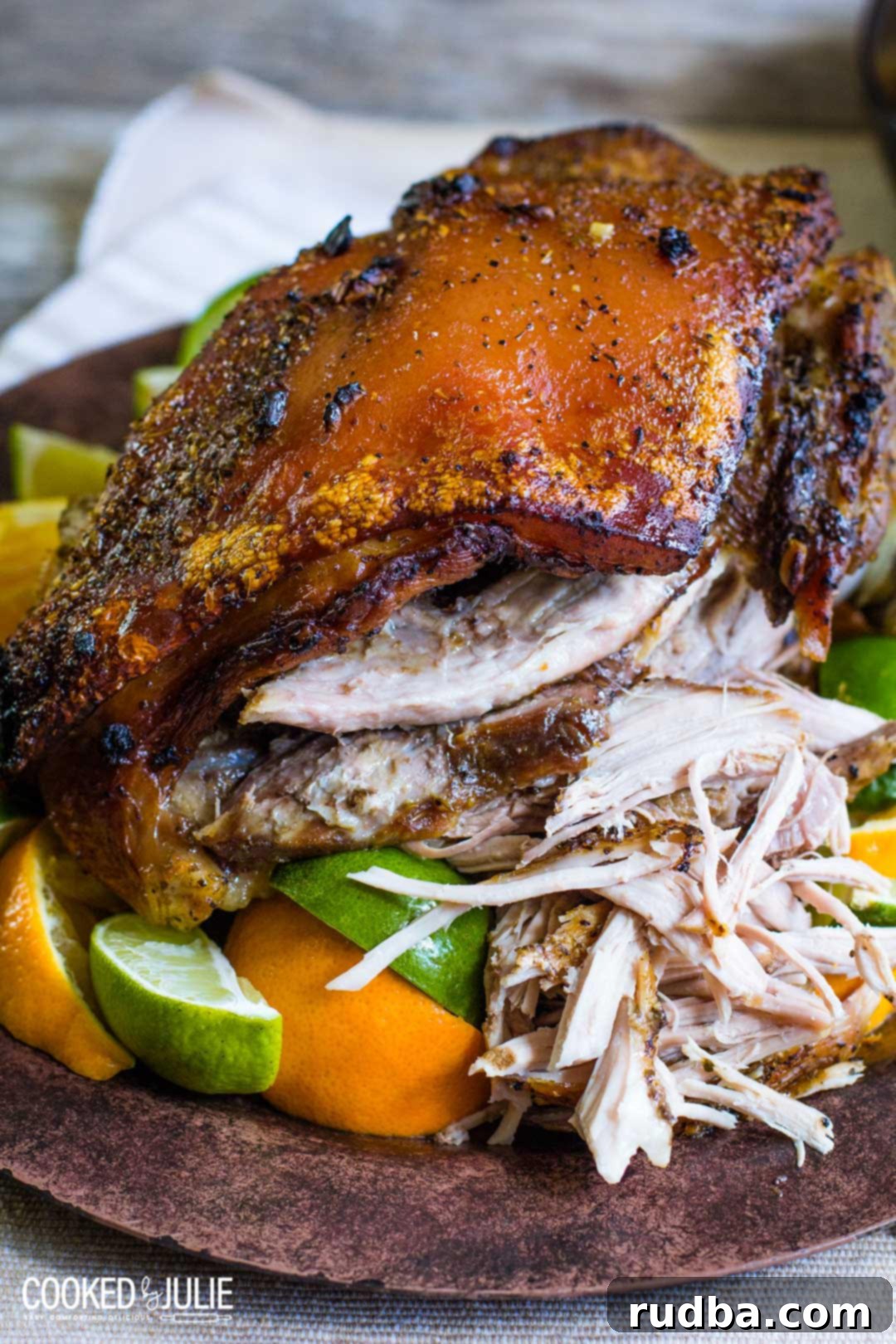
Storage and Reheating Tips for Leftover Pernil
Leftover Pernil is a true treasure, often tasting even better the next day as the flavors continue to meld. To properly store it, allow the pork to cool completely before placing it in an airtight container. For the best results, if you want to preserve the crispiness of the skin, store the crispy “cuerito” separately from the shredded meat. Refrigerate for up to 3-4 days. To reheat the meat, gently warm it in a microwave or, for a superior result, bake it in a preheated oven at 350 degrees F (175 degrees C) for 20-30 minutes, covered with a splash of broth or water to keep it moist. To restore the crunch of the crispy skin, reheat it briefly in a toaster oven or under the broiler for a few minutes until crackling once more.
More Delicious Pork Recipes To Satisfy Your Cravings
If you’ve fallen in love with the rich flavors of this Pernil recipe, you’ll surely enjoy exploring other fantastic pork dishes that are just as satisfying and delicious. Here are some of our top recommendations:
- Smothered Pork Chops: Experience ultimate comfort with these tender pork chops, slow-cooked in a rich, savory, and deeply flavorful gravy until they’re fork-tender.
- Creamy Garlic Pork Chops: A quick and easy weeknight meal, these juicy chops are enveloped in a luscious, aromatic garlic cream sauce that’s simply irresistible.
- Instant Pot Ribs: Achieve fall-off-the-bone tender ribs in a fraction of the time with this ingenious Instant Pot method, perfect for when you’re craving ribs but are short on time.
- Chuletas Fritas (Deep-Fried Pork Chops): These crispy, well-seasoned, deep-fried pork chops are a classic comfort food in many Latin American cultures, delivering incredible crunch and flavor.
Tried this recipe? Please leave a star ⭐️⭐️⭐️⭐️⭐️ rating in the recipe card below and/or a review in the comments section further down the page. Your feedback is greatly appreciated! And consider following me on Facebook, Instagram, or Pinterest for more delicious recipes and culinary inspiration!
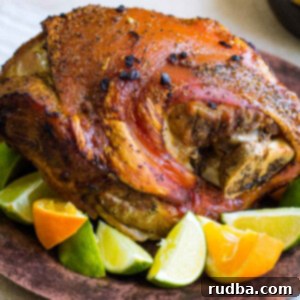
Pernil
Save RecipeSaved Recipe
Pin Recipe
Rate Recipe
Print Recipe
Ingredients
- 8 lb Pork Shoulder
- 1 orange, juiced
- 3 limes, juiced
- 7 garlic cloves
- 1 teaspoon Sazon Goya
- 1 teaspoon oregano
- 1 teaspoon cumin
- 1 tablespoon Kosher salt , plus more for seasoning pork skin
- 2 teaspoons black pepper
Instructions
-
Preheat oven to 350 degrees F (175°C).
-
To make the marinade, combine the orange juice, lime juice, minced garlic, oregano, Sazon Goya, cumin, salt, and pepper in a bowl. Whisk until well combined.
-
Carefully pull the pork skin back about 3/4s of the way from the pork shoulder (keeping it attached). Make several 1-inch deep cuts into the flesh of the pork, ensuring good pockets for the marinade.
-
Pour the marinade all over the exposed pork meat, making sure to get those garlic chunks deep inside the slits. Do not get the marinade on the pork skin; it should remain completely dry.
-
Place the skin back in position over the marinated pork. Pat the skin thoroughly dry with a paper towel; you want it to be as dry as possible. Season the dry skin generously with extra salt and pepper. Cover the entire baking dish tightly with aluminum foil and bake for 4 hours at 350 degrees F (175°C). After 4 hours, remove the foil and continue baking for 1 additional hour uncovered. After this hour, increase the oven temperature to 450 degrees F (232°C) and cook for another 15-20 minutes, or until the pork skin is beautifully golden-brown and crackling crispy.
-
Once the skin is crispy, remove the Pernil from the oven and let it rest for 10-15 minutes. Carefully slice off the crispy skin (cuerito) and set it aside. Shred the tender meat using two forks and place it back into the pan with all the delicious juices. Be careful not to get any juices on the crispy pork skin, as it will soften. Serve immediately and enjoy!
Notes
- Pull the skin back from the pork shoulder and pierce slits into the flesh. That’s going to help the marinade penetrate the pernil.
- Let the meat sit for 10-15 minutes before shredding.
- If shredding the meat, make sure you place it back into the pan along with juices.
- Make sure you use a bone-in pork shoulder or pork butt. Although, it’s part of the shoulder meat it is also known as pork butt.
- Let the pork sit at room temperature for at least 30 minutes before baking. Cold pork will take longer to roast and can cook unevenly.
- Make sure the garlic chunks get into the slits.
Nutrition
Nutrition information is automatically calculated, so should only be used as an approximation.
Additional Info
Like this recipe? Leave a comment below!
